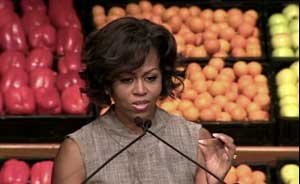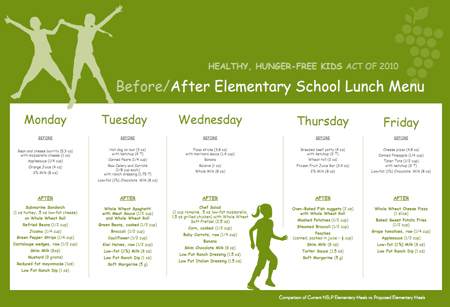 First lady Michelle Obama has championed the issue of children’s health and nutrition through her Let’s Move! campaign and other programs that improve access to fresh produce. Today, she and Agriculture Secretary Tom Vilsack announced changes to the national school lunch program, as outlined by the Healthy, Hunger-Free Kids Act that was passed last year. The act gives the USDA the authority to set nutritional standards for all foods served in schools.
First lady Michelle Obama has championed the issue of children’s health and nutrition through her Let’s Move! campaign and other programs that improve access to fresh produce. Today, she and Agriculture Secretary Tom Vilsack announced changes to the national school lunch program, as outlined by the Healthy, Hunger-Free Kids Act that was passed last year. The act gives the USDA the authority to set nutritional standards for all foods served in schools.
The event was held at Parklawn Elementary School in Alexandria, Virginia. Students and parents attending the event will be served a healthy meal prepared by celebrity chef Rachael Ray and school’s food service staff.
These are the first major changes the USDA has made in 15 years. They include making fruits and vegetables available to students every day, increasing the number of foods that contain whole grains, and making all milk options low-fat. More than 31 million children receive meals through the school lunch program.
However, the measures are not as aggressive as Obama originally hoped. In November, congress passed a bill that would allow pizza to be considered a serving of vegetables and require half of grain servings to be made with whole grains. Today’s announcement will incorporate the rulings made by congress.
Considering how long it’s been since the school lunch guidelines have been updated, a number of health experts agree that the measures are definitely a step in the right direction. “I totally support it,” says Sarah Wu, author of Fed Up with Lunch, adding that she is excited about the announcement.
“I’m very happy with the changes announced today by the first lady and I feel that they are a step in the right direction,” said Dr. Melina Jampolis, a board certified physician nutrition specialist and author. “Since obesity affects a disproportionate amount of low income children, making positive changes like adding whole grains, fruits and vegetables to the school lunch program is an important piece of the puzzle when it comes to tackling childhood obesity. I love the fact that they are not cutting the foods that kids love to eat, but rather giving them a healthy makeover!”
The largest barrier to making the school lunch standards even stronger is clearly cost, although food industry lobbyists have fought hard to keep potatoes and frozen pizzas on the menu. The original bill called for an additional six cents per meal for schools with healthier lunches, however, this was blocked by congress. “We’ve yet to see how the final ruling is going to handle that,” says Chef Ann Cooper, also known as the Renegade Lunch Lady. “But six cents is six cents and that’s great, but frankly it’s a quarter of an apple. So, it’s really not enough money to help school districts serve more fresh fruits and vegetables.”
Cooper argues that if the government really wants to cut health care costs by helping kids get healthier, they need to invest more resources into school lunch programs. However, she says that the ruling is a step in the right direction. “I think that the proposed rule is going a long way to help our nation’s children.”
You can see an example of the new school lunch guidelines at work in this document from the USDA. It compares a typical school lunch menu before the change, and what the menu will look like now. For instance, on a Tuesday, students would have had a hot dog with ketchup, canned pears, raw celery and carrots with ranch, and low-fat chocolate milk. Now, they’ll have whole wheat spaghetti with meat sauce, a whole wheat roll, green beans, broccoli and cauliflower, kiwi, low-fat milk, low-fat ranch, and soft margarine.
Also Read:
Chef Ann Cooper’s Proposed Changes for a Healthier School Lunch Program
SchoolMenu Serving Up School Lunch Support Districts and Parents Need

